Key Points:
- During their migrations from May to November, more than a dozen shark species, some relatively unknown, visit Cape Cod waters.
- These shark species include great white sharks, basking sharks, blue sharks, shortfin mako sharks, sand tiger shark, spiny dogfish, porbeagle sharks, thresher sharks, dusky sharks, and hammerhead sharks.
- The porbeagle is the only shark on this list that lives on Cape Cod year-round. Rising water temperatures have resulted in more observations of warmer-weather species, such as hammerhead sharks, in recent years.
Cape Cod, Massachusetts, is known for its lobster rolls, laid-back lifestyle, and beautiful scenery that make it a dream place to call home. The beaches of Cape Cod and the Islands offer superb sand, swimming, and water sports. However, when something is too good to be true, there is a huge chance that it is indeed. Cape Cod is a very popular summertime destination. However, that does not mean its waters are free of sharks. So, what are the sharks in Cape Cod, and what seasons of the year do they come there?
The Cape is home to some of the world’s largest sharks, including one of the world’s most feared. Sharks love to swim in Cape Cod’s water, and for a good reason: it boasts temperate waters and a moving feast of seals and fish. More seals have packed popular Cape beaches since 1972, bearing legendary apex predators with them. “Shark tourism” has brought thousands of visitors from around the region to observe these exquisite and ferocious creatures in recent years. This article will explore the types of sharks that lurk beneath Cape Cod’s waters and when they congregate in the area.
10 Sharks on Cape Cod
1. Great White Shark

Sharks are most commonly seen on Cape Cod throughout the summer months.
©Martin Prochazkacz/Shutterstock.com
The number of great white sharks lurking beneath Cape Cod’s waters has doubled in the past years. Shark attacks are rare in the area, but that doesn’t mean that it is entirely safe to swim with great whites. The expanding population of great white sharks on Cape Cod results from an increasing seal population. Since seals are one of the ferocious shark’s main meals, fecal remnants of seals are carried through ocean waters, reaching natural-born hunters such as great whites. The great white shark’s keen sense of smell drives it towards a population of about 50,000 seals on Cape Cod, causing the shark species to also grow in number.
Sharks are most commonly seen on Cape Cod throughout the summer months, from May to November. Great white activity increases as the water warms up and continues into the fall, which is also when the Cape’s tourism season begins. Footages of great whites munching on seals are prevalent every summer, and beaches are often closed for swimming in some areas due to shark sightings.
According to the Cape Cod Chamber of Commerce, only .0017857 miles of the Cape’s 559.6 miles of shoreline are documented to have sharks.
2. Basking Sharks

The basking shark has a huge geographic range that spreads across wide swaths of the Pacific and Atlantic oceans.
©Martin Prochazkacz/Shutterstock.com
Basking sharks are the second-largest fish in the ocean and are frequently confused with white sharks. After a video was posted on the Internet and received tens of millions of views, a basking shark spotted miles off the shore of Cape Cod in June 2021 drew widespread notice. The student researcher who captured the clip said he was glad to see so much interest in the shark but that it was nothing to be terrified of.
The basking shark has a huge geographic range that spreads across wide swaths of the Pacific and Atlantic oceans. Because they prefer cool to moderate settings, they do not live in the Arctic, Antarctica, or tropical areas. However, throughout their long migratory paths that can span thousands of miles, they may travel through tropical seas, like those off the coast of Cape Cod, Massachusetts.
3. Blue Sharks
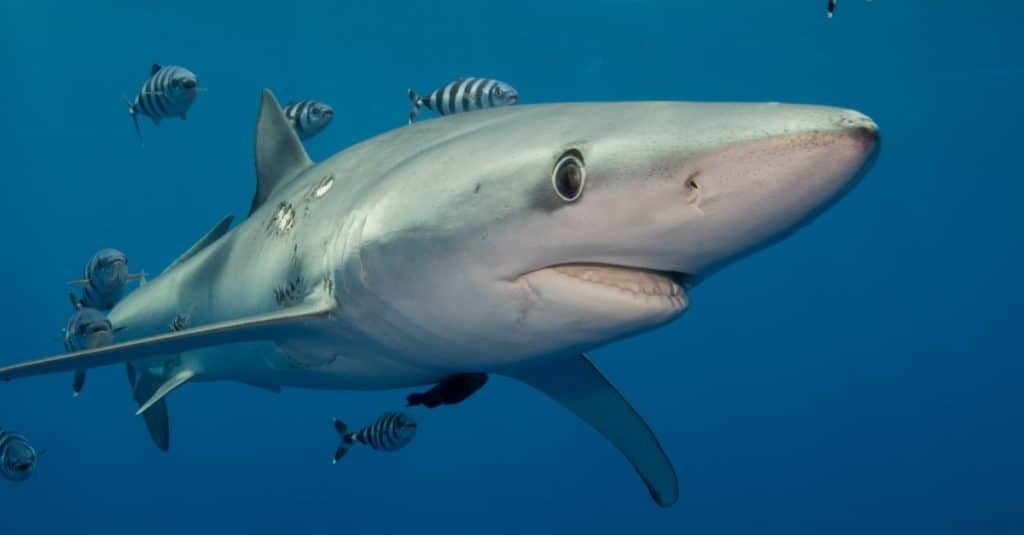
Blue sharks are attracted to areas surrounding boats when chum is tipped into the water.
©Jan Finsterbusch/Shutterstock.com
These curious sharks are known to hang out near boats, especially when chum is thrown overboard. Some of the largest blue sharks in the Cape Cod area have been reported by scientists and anglers alike. When a blue shark surfaced in the local marsh in November of 2020, experts and residents in the Cape Cod hamlet of Eastham, Massachusetts, were perplexed. When the blue shark swam inside the curved bulk of Cape Cod, into First Encounter Beach, and subsequently Bee’s River Marsh, it was most likely on its way south for the winter from the Gulf of Maine. According to the state Division of Marine Fisheries, Cape Cod is a major migration route for a variety of species because its hook catches southerly animals.
4. Shortfin Mako Shark

Mako sharks
are frequently misidentified with great white sharks due to their striking resemblance.
©Xavier ELIAS Photography/Shutterstock.com
During their migrations from May to November, more than a dozen relatively unknown shark species, including the shortfin mako, visit Cape Cod waters. Mako sharks are frequently misidentified with great white sharks due to their striking resemblance. Makos are normally 8 to 10 feet long, with silvery-blue top halves and silvery-white bottoms. Makos have more slender heads and appear to have less “girth” than white sharks. Mako sharks are among the fastest, strongest, and most dangerous sharks that can be caught off the coast of Cape Cod.
The shortfin mako shark can be found off the coast of all seas in tropical and mildly temperate regions. However, it has been known to go to cooler waters on occasion. It is the fastest shark species known, with top speeds of 31 mph and bursts of 46 mph!
5. Sand Tiger Shark
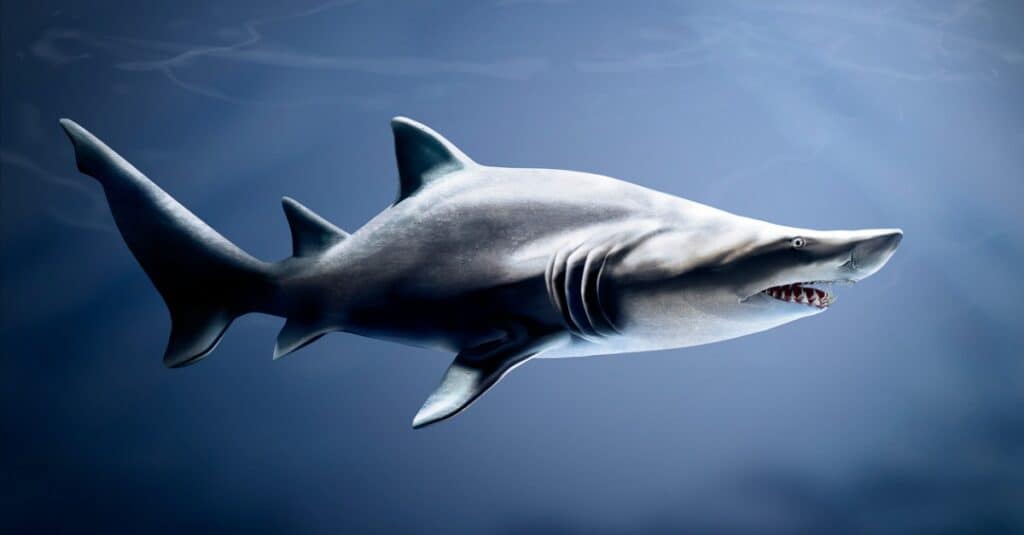
Sand
tiger
shark mothers can eat their young while they are still in utero.
©iStock.com/mirror-images
Buzzards Bay, Vineyard Sound, and Nantucket Sound are the principal coastal sea masses south of Cape Cod. The sand tiger shark is one of the shark species found in coastal areas north and south of Cape Cod. Sand tiger sharks are common on Massachusetts’ shallow shores and can be caught by anglers standing on the beach. According to National Geographic, despite their intimidating appearance, sand tigers are normally non-aggressive until provoked. Sand tigers are also the only sharks known to surface for oxygen.
These sharks can be found in warm waters worldwide, notably off the east and south coasts of the United States, the southeastern coast of South America, the Mediterranean, and the coasts of Africa, Australia, China, and Indochina. Though they can dive to nearly 600 feet, they prefer to hunt in shallow waters at night.
6. Spiny Dogfish
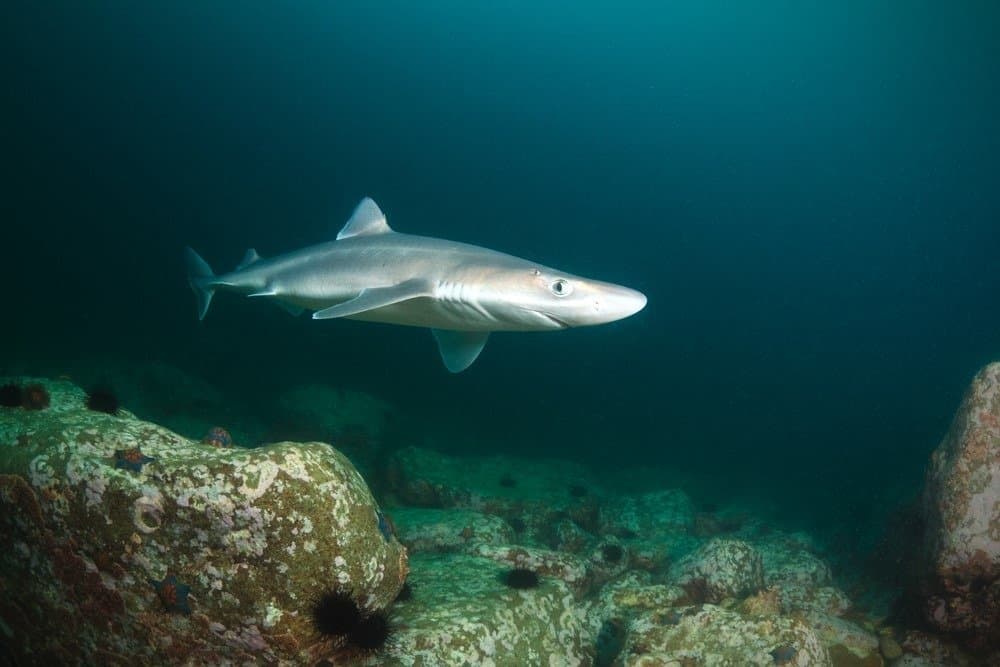
The spiny dogfish is often known as the dogfish shark.
©Boris Pamikov/Shutterstock.com
Because it is more numerous than cod and other groundfish, the Cape Cod Fisherman’s Alliance has recently pushed the spiny dogfish as the next seafood source. These sharks are far shorter than any of the others listed, and they are most likely to have been sighted by anglers looking for bottom-feeding species such as flounder and scup.
The spiny dogfish, often known as the dogfish shark, reaches a maximum length of 39 inches for males and a maximum length of 49 inches for females. The majority of them are around 8 pounds in weight and live in the Atlantic and Pacific Oceans. The spiny dogfish seen in the Pacific has recently been identified as a different species and was named Pacific Spiny Dogfish.
7. Porbeagle Sharks
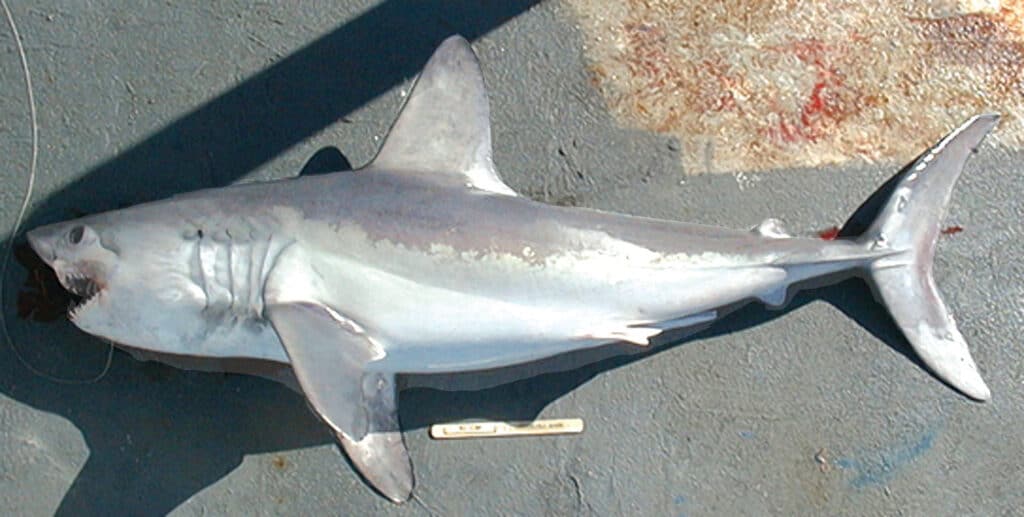
The porbeagle alternates between shallow and deep water depending on the season or day.
©NOAA, Public domain, via Wikimedia Commons – License
The porbeagle is the only shark on this list that lives on Cape Cod year-round and has a remarkable temperature tolerance. In contrast to the more angular, triangle-shaped dorsals of the great white, their dorsal fins have a unique patch of white on the back and a rounded top.
A 6-foot porbeagle washed up on the beach a half-mile north of Marconi Beach on Cape Cod in 2019. The porbeagle shark can often be found in the North Atlantic, Mediterranean Sea, and areas of the South Pacific, including the shores of Australia and South Africa. Depending on the season or day, it alternates between shallow and deep water.
8. Thresher Shark
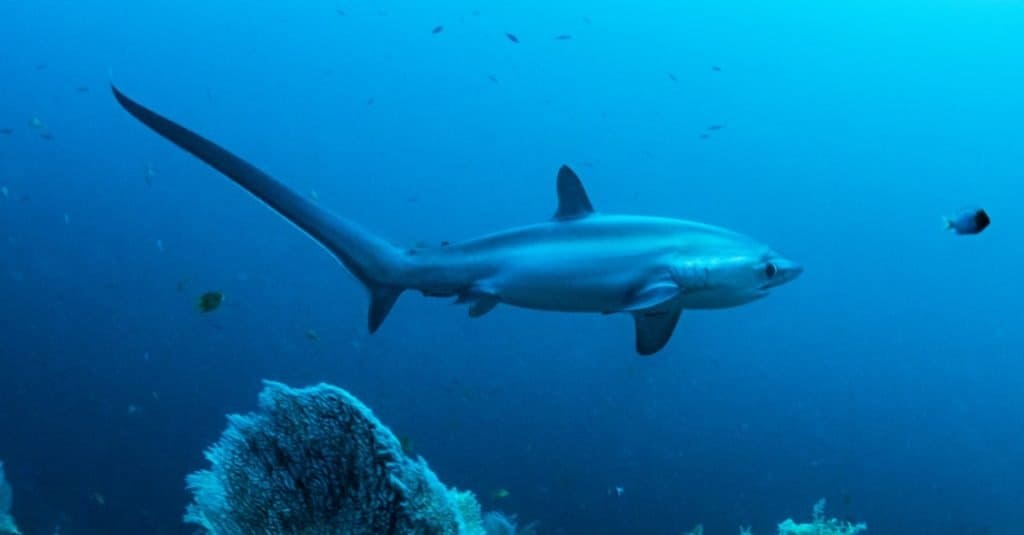
Thresher sharks live in temperate waters worldwide, including the northwest Atlantic Ocean.
©Shane Gross/Shutterstock.com
Four thresher sharks arrived on Cape Cod’s coasts in 2017, but not in the traditional rippling swim pattern of cartilaginous fish. After becoming trapped on numerous beaches, these sharks were discovered dead and frozen. During the winter, shark strandings along Cape Cod are not uncommon, and thresher sharks are among the stranded species. Over continental shelves, common threshers are more frequent in coastal seas. They live in temperate waters worldwide, including the northwest Atlantic Ocean, where they can be found from Newfoundland to Cuba.
9. Dusky Shark
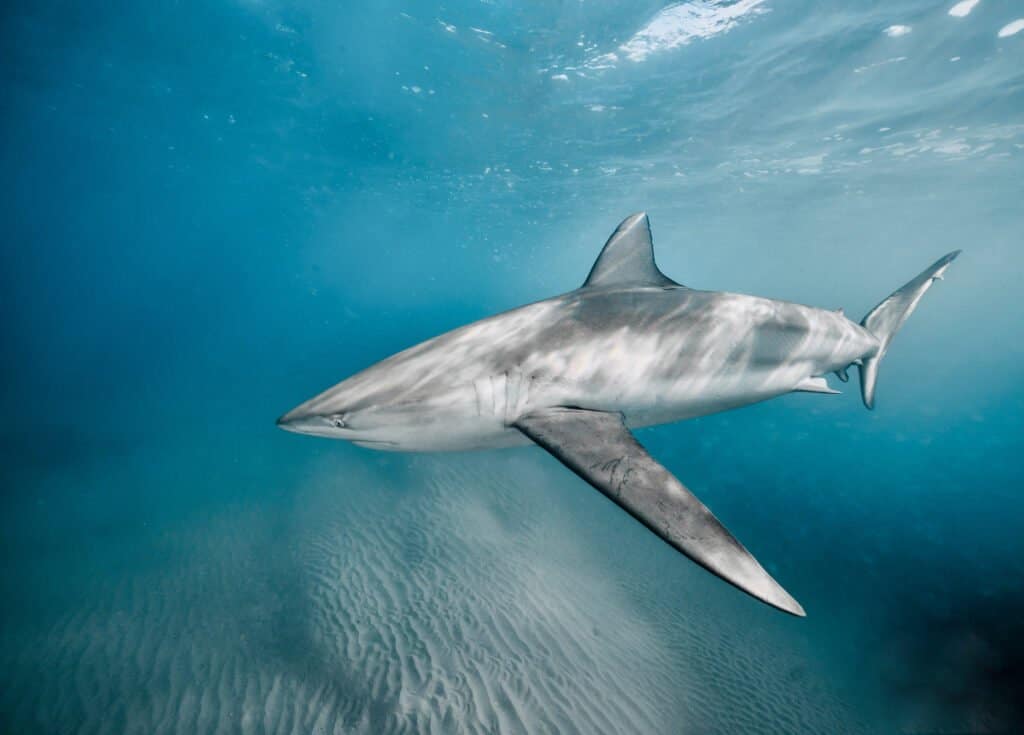
Dusky sharks have a less numerous population than other shark species on Cape Cod.
©sirtravelalot/Shutterstock.com
Cape Cod divides the Massachusetts coastline into two general zones regarding shark nursery habitat. The peninsula is the northern limit of the geographical distribution of a few coastal shark species, including the dusky shark. The dusky shark is a requiem shark that can be found in tropical and warm-temperate continental seas worldwide. It can be seen from Massachusetts (including Cape Cod) and the Georges Bank to Southern Brazil, including the Bahamas and Cuba, in the western Atlantic Ocean. As they are apex predators, dusky sharks have a less numerous population than other shark species on Cape Cod.
10. Hammerhead Shark
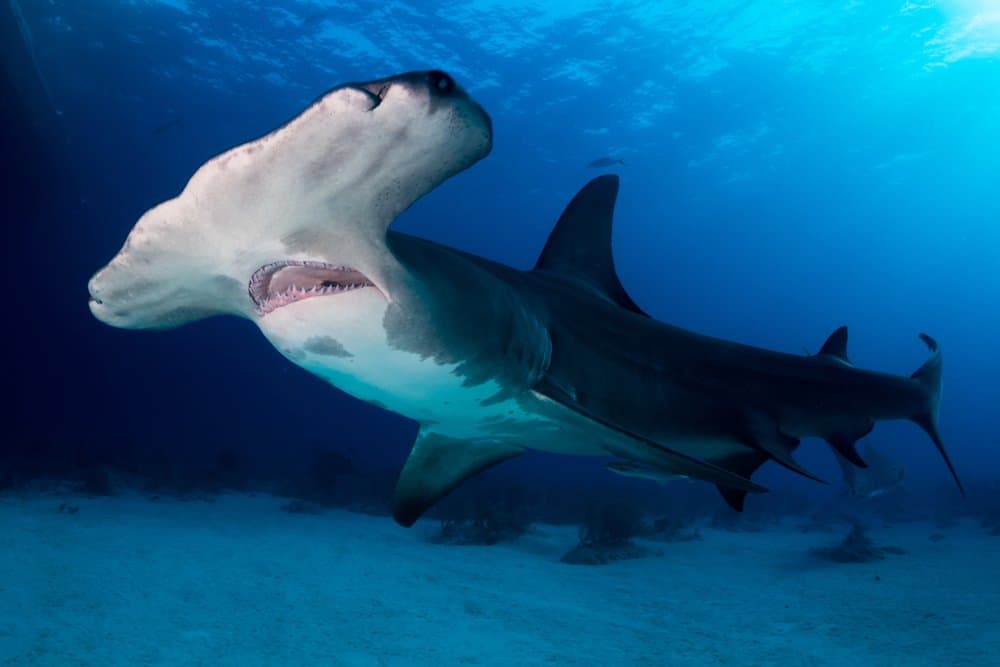
Hammerhead sharks and other warm-water species cannot regulate their body temperature via producing heat.
©HakBak/Shutterstock.com
Although sightings of hammerhead sharks on Cape Cod are rare, their presence in the area is still worth noting. While seeing a white or blue shark off the Cape shore is not uncommon, fishermen and biologists have reported seeing hammerhead sharks in 2020, which is a new scenario for Massachusetts beaches. Hammerhead sharks, whale sharks, and other warm-water species such as bull and tiger sharks typically avoid the cold seas of New England. Hammerhead sharks and other warm-water species, unlike great white sharks, cannot regulate their body temperature via producing heat. However, the Massachusetts Division of Marine Fisheries reports that rising water temperatures have resulted in more observations of warmer-weather species in recent years.
The photo featured at the top of this post is © Antonio Viesa/Shutterstock.com
Thank you for reading! Have some feedback for us? Contact the AZ Animals editorial team.






